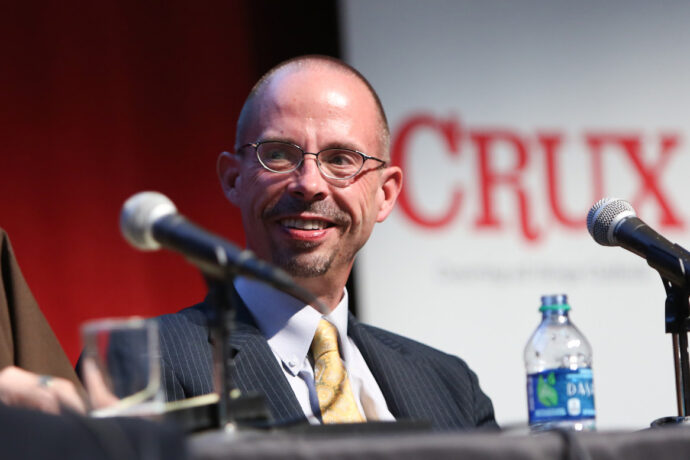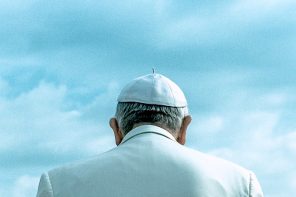On March 14 of this year, the Boston Globe announced it would be pulling the plug on Crux, the Catholic news website it launched in 2014. Crux was headed by John Allen Jr., a veteran church reporter who had previously written for National Catholic Reporter, CNN, NPR and many other outlets, most of them operating independently of the Catholic church.
Allen has also written several books about the Vatican, including a 2000 biography of then-cardinal Ratzinger that was seen by many as critical of the former prefect of the Vatican’s Congregation for the Doctrine of the Faith. In spite of some readers holding the opinion that Allen’s work veers toward the liberal side, Allen has strived for neutrality as a journalist, thus making him a logical pick to head the Globe’s venture into Catholic journalism.
In its brief existence, Crux quickly became an important voice in church news. Because most secular outlets only give limited coverage to religion news, it can be difficult for readers to find stories about the Vatican and the pope that aren’t slanted in one way or another. National Catholic Reporter is run by lay people, as is Commonweal. Both tend to attract what could be described as more liberal contributing writers, but because of their editorial freedom, they are able to wrestle with issues like women’s ordination, marriage equality, and birth control. Religion News Service also covers the Catholic church, and is run by a secular nonprofit, as is this website. (Full disclosure: I have written for all of the above, as well as for America magazine.)
Other models of Catholic church news sources, however, fall under Vatican jurisdiction. This sometimes skews their ability to have complete editorial control. America magazine is supported by the Jesuits, and its former editor, Thomas Reese, SJ, was pressured into resigning due to objections to magazine content from the Congregation for the Doctrine of the Faith, at the time headed by the same Cardinal Ratzinger. As a news outlet supported by a religious society, the magazine tends to strive for a neutral point of view. Matt Malone, SJ, its current editor in chief, banned the terms “conservative” and “liberal” from the magazine in 2013, when he stated that terms like “left” and “right” are “counterproductive” in a Catholic context. US Catholic, published by the religious order of Claretians, often aims for a similar middle ground.
The National Catholic Register (not to be confused with the National Catholic Reporter) was formerly controlled by the scandal-plagued Legionaries of Christ, and in 2011 it was purchased by Eternal World Television Network (EWTN), founded by the recently deceased Mother Angelica. EWTN is known for what can best be described as a traditionalist slant; its daily mass broadcast features several segments in Latin; and its rotation of shows focusing on doctrinal issues and conversion of non-Catholics, include “My Catholic Family,” “Household of Faith,” “Angel Force,” “Catholics Coming Home,” and many more. The National Catholic Register shares many personalities with EWTN and editorially it generally mirrors EWTN’s point of view.
Crux, like America, aimed for a middle ground, but it was also supported by a secular news organization with the financial and editorial muscle of the Globe behind it. It incorporated in-depth reporting on the American church from Michael O’Loughlin, columns from Margery Eagan, and Rome reporting from Allen and Ines San Martin. The Boston Globe’s reputation for fierce honesty in its church coverage helped bolster the site, and Allen’s decades of experience, coupled with the skill of its writing staff, made the site an important voice. In the small hive that is Catholic journalism, Crux had a lot of buzz.
What it did not have was a lot of money. The Globe’s strategy was to hopefully attract what editor Brian McGrory described as “big-ticket, Catholic-based advertisers.” But those advertisers did not materialize. And while the site attracted a good-sized readership, without ad clicks it wasn’t generating cash for the Globe, which pulled the plug and gave Allen control of the site, while laying off O’Loughlin and Eagan in the process (editor Theresa Hanafin was reassigned to another desk at the Globe).
Allen quickly told journalists covering the news that the site was not dead, but was seeking funding from other sources. Within just a few days, he found it. The Knights of Columbus, a Catholic fraternal organization with nearly two million members, stepped up to support Crux. Allen and Vatican correspondent Inez San Martin would remain on staff, and Allen joked to Nieman Lab that the Knights’ buyout was a “corporate resurrection. We died and rose again on the third day.”
Allen was insistent that the Knights’ interest in Crux did not mean they would assert editorial control over the site; he told Neiman Lab that “they’re getting into because they like what we do and they want to support it,” and that the Knights’ financial support represented “a partnership, not a buyout.” The Knights would provide Crux with financing, Allen said, but it was up to the reduced Crux staff to decide how to allot that money; meanwhile, as they had at the Globe, they would continue to seek advertising from Catholic organizations.
Whether the site will retain true editorial independence under the Knights’ sponsorship, however, is an open question. The Knights have long been known as the “strong right arm of the Church,” according to Archbishop Lori, who is the head of the USCCB’s Ad Hoc Committee for Religious Liberty, and the Supreme Chaplain of the Knights. Lori told the Catholic News Agency in 2011 that the Knights “are the families that are promoting priestly and religious vocations… [and they] step up and defend the Church whether it’s bishops, priest or the Pope himself when it is appropriate to do so.”
The Knights are known for their charitable giving; in 2013, they donated over $170 million to various causes. Many of those include victims of natural disasters as well as man-made ones, like the victims of the Boston Marathon bombing and the Newton school shooting, and they’re similarly well known for their support of the disabled. But the Knights have not remained politically neutral, and have often worked against the American separation of church and state. According to Christopher Kauffman’s book Faith and Fraternalism, lobbying from the Knights helped get the phrase “Under God” inserted into the Pledge of Allegiance and led to Columbus Day being recognized as a federal holiday.
More recently, the Knights contributed over a million dollars to Proposition 8, which temporarily overturned marriage equality in California. They made similar million-dollar plus contributions to campaigns in Maine, Maryland, Minnesota and Washington. In 2005, they printed 800,000 postcards in Canada “in a campaign that [argued] that the redefinition of marriage to include gay and lesbian couples would promote pedophilia, pornography and unsafe sex.” As Marianne Duddy-Burke of the LGBTQ Catholic organization Dignity USA commented in a press release, “The Knights are deeply invested in advancing a particular brand of Catholicism, and I am concerned that Crux’s coverage of the diversity and breadth of our Church will be diminished.”
Presidents Nixon, Reagan, H.W. Bush and George W. Bush all spoke at the Knights’ Supreme Convention; Presidents Clinton and Obama sent written messages to the convention. JFK was a Knight, as was Ted Kennedy; John Boehner and Jeb Bush are currently members.
Given the Knights’ political leanings versus Allen’s insistence on the site’s editorial independence, it’s difficult to imagine what Crux 2.0 will look like, but recent headlines provide some perspective. Admittedly, this is an unscientific analysis of potential changes, but as a regular reader, the front page of Crux represents a marked drift toward just the kind of Church-friendly coverage many fear the site will begin to feature. This morning, the death of EWTN’s Mother Angelica is greeted with a tribute from Allen entitled “We shall not look upon the likes of Mother Angelica again.” It’s a fairly balanced account of her life, but it also reiterates Mother Angelica’s scrappy insistence on orthodoxy as a model for women “wielding real power inside an organization often perceived as a boys’ club.”
News about the recent bombing in Pakistan is focused on “anti-Christian hate,” several headlines about Pope Francis focus on his Easter message, and in the latest installment of “Papal Phone Calls,” Pope Francis called a sick seminarian and told him to “keep his chin up.” An analysis of the murder of a Congolese priest again focuses on anti-Christian attitudes and calls for a “new concept of martyrdom.” The focus of the site seems to be moving more toward being about Pope Francis and anti-Christian terrorism abroad, and less about the American church and the laity.
Where Crux will go from here is unknown, but its demise as a project of secular journalism about the church, and its move toward being supported, at least in part, by a Vatican-sponsored fraternal organization may not bode well. Allen is still one of America’s most respected writers on the Vatican, but the Knights, after all, are still a “strong right arm of the church.” And in a larger sense, the dwindling coverage of religion in mainstream news outlets, at a time when religious literacy is a growing global issue of urgency, is troubling.
The Globe was showered with praise when Spotlight won an Oscar for best picture, but it pulled the plug on Crux right around the same time, an ironic maneuver that makes many wonder who will be the next Spotlight team when it comes to the still serious problems of sex abuse, misogyny, homophobia and corruption in the Catholic church that impact millions of people worldwide.
Writers and editors still care about these issues, but news corporations have largely shown that they don’t. A celebrity pope can garner headlines, but will we also lose headlines about a priest denying communion to a gay couple, an archbishop demanding teachers sign a morality clause, or even the efforts to support immigrants? These stories are the ones that affect people every day, far beyond the reaches of the Vatican walls. Some of us will keep trying to tell these kinds of stories. But with fewer secular organizations supporting that kind of journalism, those stories will increasingly get lost. With that loss, the agency of the laity in the church is lessened, and the power of the people at the top of the church to seize and control the narrative grows.





